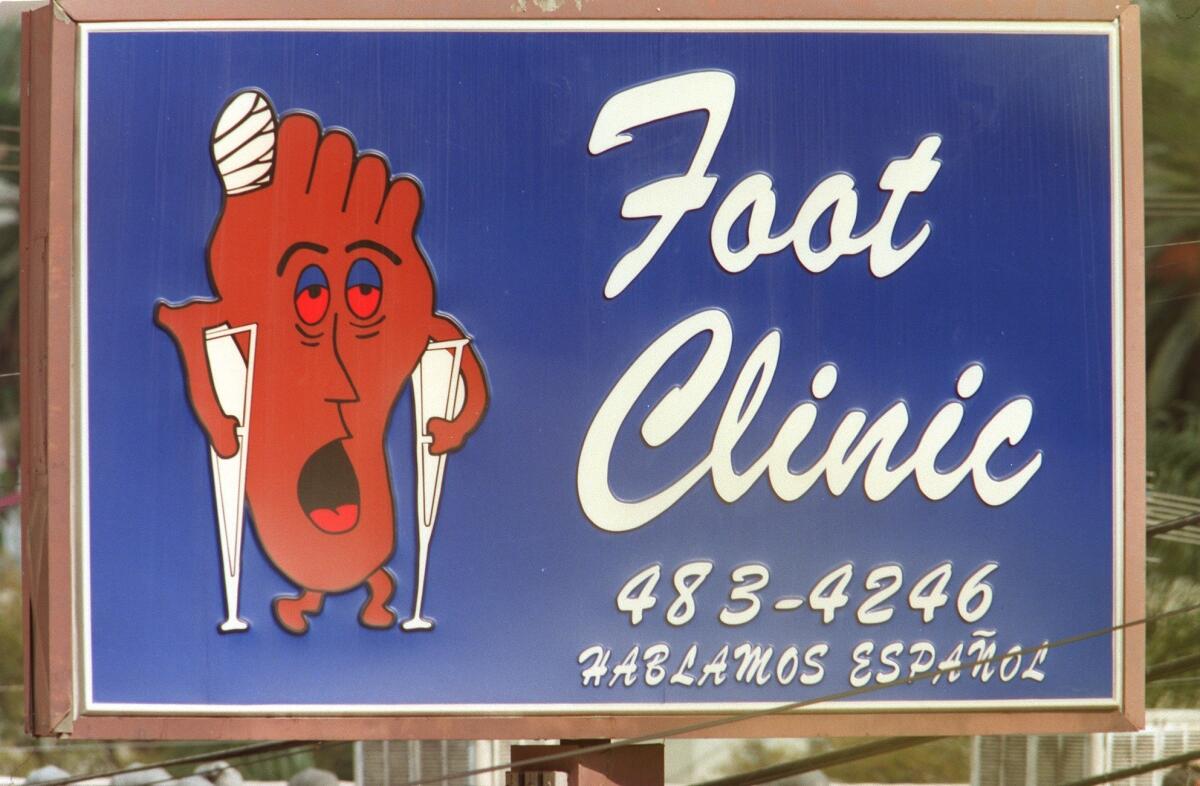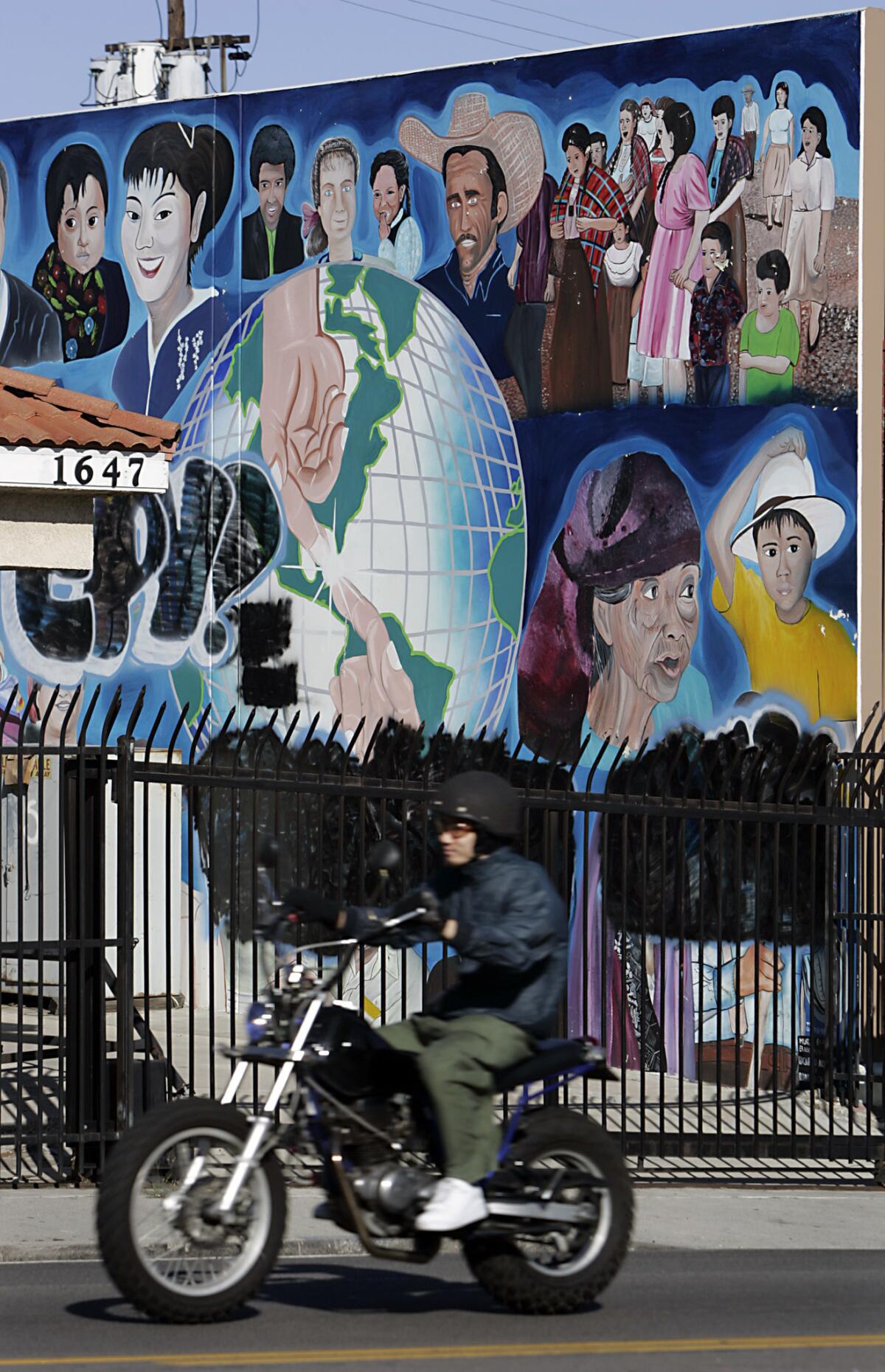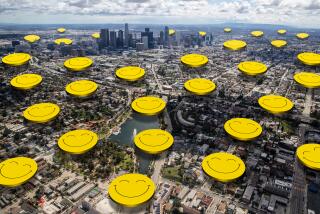The Happy Foot Sad Foot sign is moving. These books may fill the foot-shaped void in your heart

Los Angeles was delivered a body blow recently: Our most important sign is moving south. No, not the Hollywood sign; that’s faithfully waiting to be blown up in the next movie apocalypse. I’m talking about the hallowed Happy Foot Sad Foot Sign that has rotated at the corner of Sunset Boulevard and Benton Way for nearly 40 years. The sign unofficially marks the border between Silver Lake and Echo Park and also serves as a podiatry-themed prognosticator for anxious TV writers, CBD oil masseuses, indie band bassists, nannies with strollers and whomever else passes its perch.
Legend goes, as former Silver Lake resident Beck told Anthem magazine in 2004, that if you see the happy side first (the picture of the foot cheering while wearing white Mickey Mouse style gloves), you’ll have a good day. If you see the other side (a suffering foot hobbling on crutches but with, curiously, two healthy feet supporting his foot-body) ... well, better luck tomorrow.
Related: The Silver Lake Happy Foot Sad Foot sign is getting the boot »
Truth is the Happy Foot Sad Foot Sign, which has been immortalized in a song by the Eels, a video from the band Yacht and a live choral performance from Machine Project, is only moving to nearby Rampart Village to join its owners, the Sunset Foot Clinic, at their new location. It won’t happen till September-ish, but we wonder what will happen to the neighborhood, which has been dubbed HaFoSaFo. To help process the instability prompted by the HaFoSaFo move, we’ve gathered this helpful guide to four books and one podcast with ties, direct or spiritual, to the sign. These soothing words shall ease our emotional bunions and help us root back into the earth.
Jonathan Lethem, “You Don’t Love Me Yet”
Lethem’s 2008 novel about an unnamed and forever struggling band on the cusp of making it isn’t as beloved as “Motherless Brooklyn” or “Fortress of Solitude,” to be clear. But it wins a spot on this list for memorializing the Happy Foot Sad Foot sign as a key aspect to survival in the wild woods of the Silver Lake music scene. Lucinda, the book’s main character, can see it from her apartment window: “Lucinda’s view took in a three quarter’s slice of the sign as it turned in its vigil over Sunset Boulevard: happy foot and sad foot suspended in dialog forever. The two images presented not so much a one-or-the-other choice as an eternal marriage of opposites, the emblem of some ancient foot-based philosophical system. This was Lucinda’s oracle: once glance to pick out the sad or happy foot, and a coin was flipped, to legislate any decision she’d delegated to the foot god.”
Also, a bonus mention goes to David Foster Wallace’s “The Pale King,” which describes a sign very much like the HaFo SaFo, albeit in Chicago. Wallace’s sign bestowed blessings upon the students in “The Pale King:” “If it stopped with the foot facing our windows,” the narrator explains, “we would take it as a ‘sign’ (with the incredibly obvious double-entendre) and immediately blow off any homework or supposed responsibility we had.”
Barbara Thomason, “100 Not So Famous Views of L.A.”
Certain icons in Los Angeles have gotten more than their fair share of play – the Capitol Records building, Bob’s Big Boy, the Hollywoodland real estate sign of yore – but painter Barbara Thomason set her sights on the lesser-known sites in her book of paintings from 2014. Taking walks from her Franklin Hills home, Thomason was inspired to make the Angeleno version of Hiroshige’s acclaimed print series, “One Hundred Famous Views of Edo.” Her rendering of the Happy Foot Sad Foot, alone in a strip mall on Sunset without pedestrians or cars, captures the sign in all its banal and lonely glory. Thomason calls the sign “a beacon in the darkness” and says that though she does pay attention to what side she sees first, she’s just as happy to see the sad foot. “I love landmarks and especially landmarks with humor,” she told the Los Angeles Times. “It makes the neighborhood feel special.”
David Hallberg, “A Body of Work: Dancing to the Edge and Back”
You know what really bangs up the feet? Ballet – particularly a fanatical devotion to it. As a child, David Hallberg, the first American to join the Bolshoi Ballet as a principal while simultaneously dancing with the American Ballet Theatre, was ruthlessly bullied by homophobic classmates in Arizona, one element in a painful past that drove his “insatiable hunger to dance.” In his prime, Hallberg suffered a foot injury, further exacerbated by a botched surgery. The pain was excruciating, he writes: “My Achilles tendon started to produce a very sharp pain at the base of my heel … it hurt just as I pushed off for a jump, when the heel raises ever so slightly. The pain built and built. The more I tried to push through it, the worse the sensation. Like a knife stabbing my tendon.” Eventually, Hallberg made his way back to dancing, but not before confronting the ravages of his addictions and ego, not to mention his throbbing foot.
Book lovers! Sign up for the new L.A. Times Book Club for upcoming author events »
“Jung on Synchronicity and the Paranormal,” edited by Roderick Main
Ready to dive into the psyche? The idea that the Happy Foot Sad Foot sign can either predict your day, or give you permission to have the kind of day you’re meant to have, a la “The Pale King,” ties into Carl Jung’s principle of synchronicity. Jung developed the concept in the early 1930s after discussions with frequent dinner guest Albert Einstein, who was still honing his Theory of Relativity. Synchronicity is the name for when ostensibly unrelated events coincide in unlikely ways that have some sort of significance for you. Jung believed synchronicities were evidence of a unifying consciousness at play in the universe, creating physical manifestations of what we’re wrestling with in our psyches. So, in other words, whether you get the happy foot or the sad foot while driving by (or walking, when you can really hear HaFoSaFo’s rotating gears in all their creaky splendor) may not be a coincidence, exactly, but a resonating crackle with whatever else is going on in your life. If only Jung had weighed in on what it means for a foot to have his own feet, which is the ultimate paradox of the HaFoSaFo sign.

So where exactly is the sign going? It’s moving near Beverly and Virgil boulevards. It’s technically Rampart Village, but adjacent to one of L.A.’s most rapidly changing and undersung neighborhoods: Historic Filipinotown. For those wanting a native, on-the-ground view of the area, there’s no better podcast than “This Filipino American Life,” hosted by Joseph Bernardo, Ryan Carpio and Elaine Dolalas, who live in — or have deep roots to — Historic Filipinotown.
Episode 85, in particular, asks if Filipinos “need” their own ethnic enclaves and takes a close look at Historic Filipinotown, designated as such in 2002, and Episode 13 looks at the area’s rapid gentrification. When asked about HaFoSaFo sign, producer Michael Nailat says “it’s another indicator of the changes happening in L.A. overall.” HiFi, as its called by the locals, has seen a wave of new businesses in the last few years alone, including the Filipina American-owned cocktail spot Genever, and Tactile Coffee, owned by two Korean American brothers. Nailat says that many of the newcomers “are connecting with and engaging with the HiFi community, hearing their concerns and working toward serving it first and foremost. So while change often feels inevitable, HiFi has the opportunity to show what change that benefits everyone can look like.”
Like many who have faced a changing L.A., the Sunset Foot Clinic owner, Thomas Lim, decided to move after his lease wasn’t renewed. But as he tells The Times, the HaFoSafo sign “was a happy accident.”
More to Read
Sign up for our Book Club newsletter
Get the latest news, events and more from the Los Angeles Times Book Club, and help us get L.A. reading and talking.
You may occasionally receive promotional content from the Los Angeles Times.






